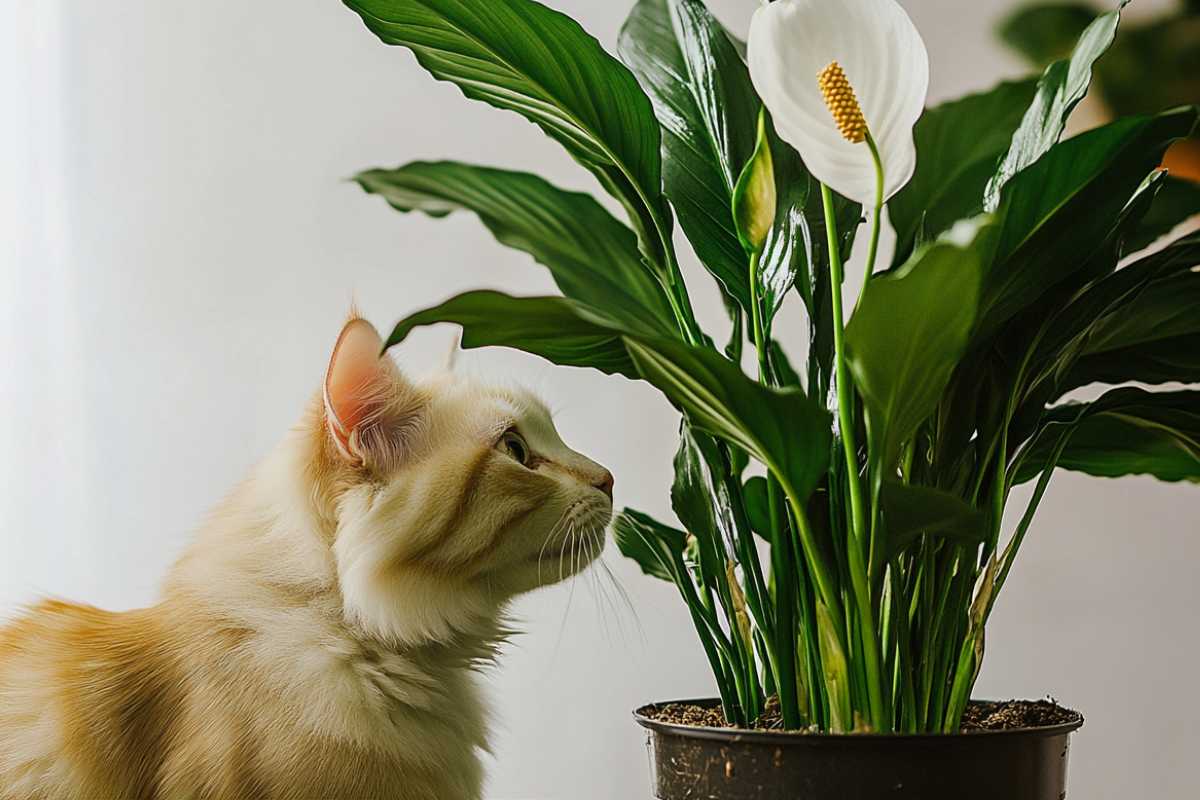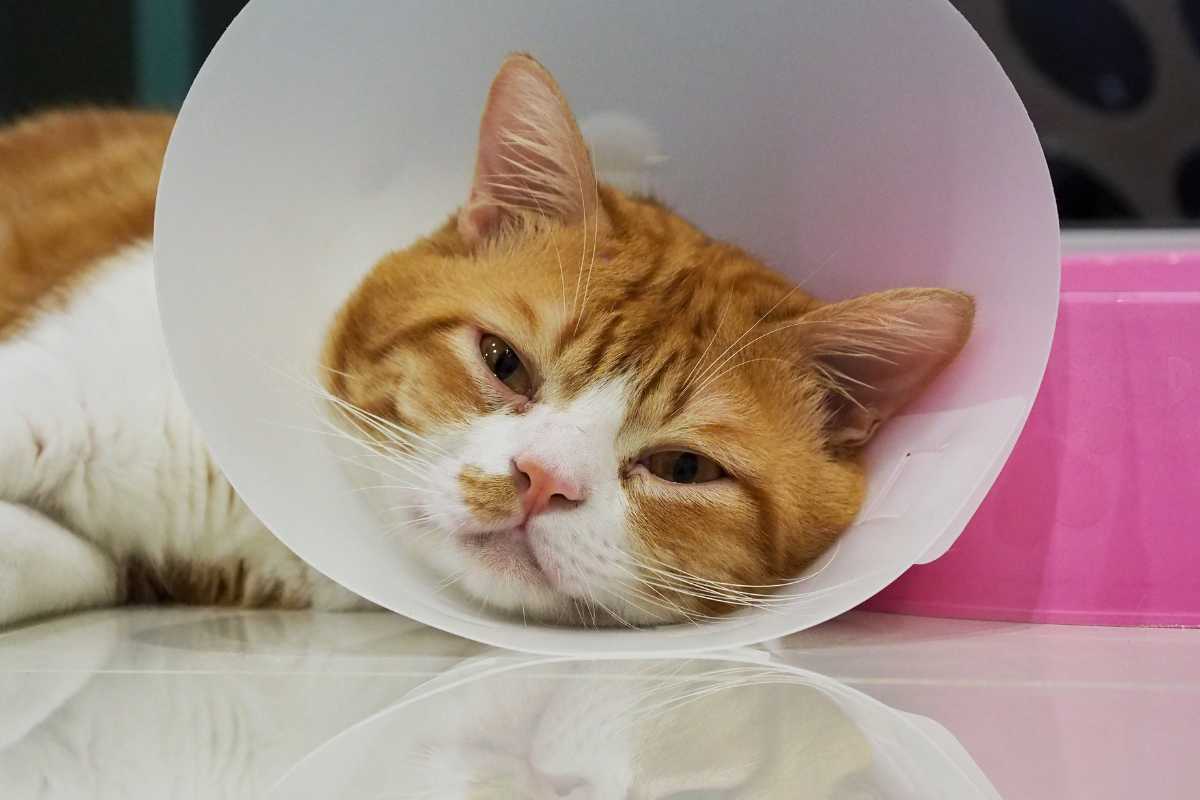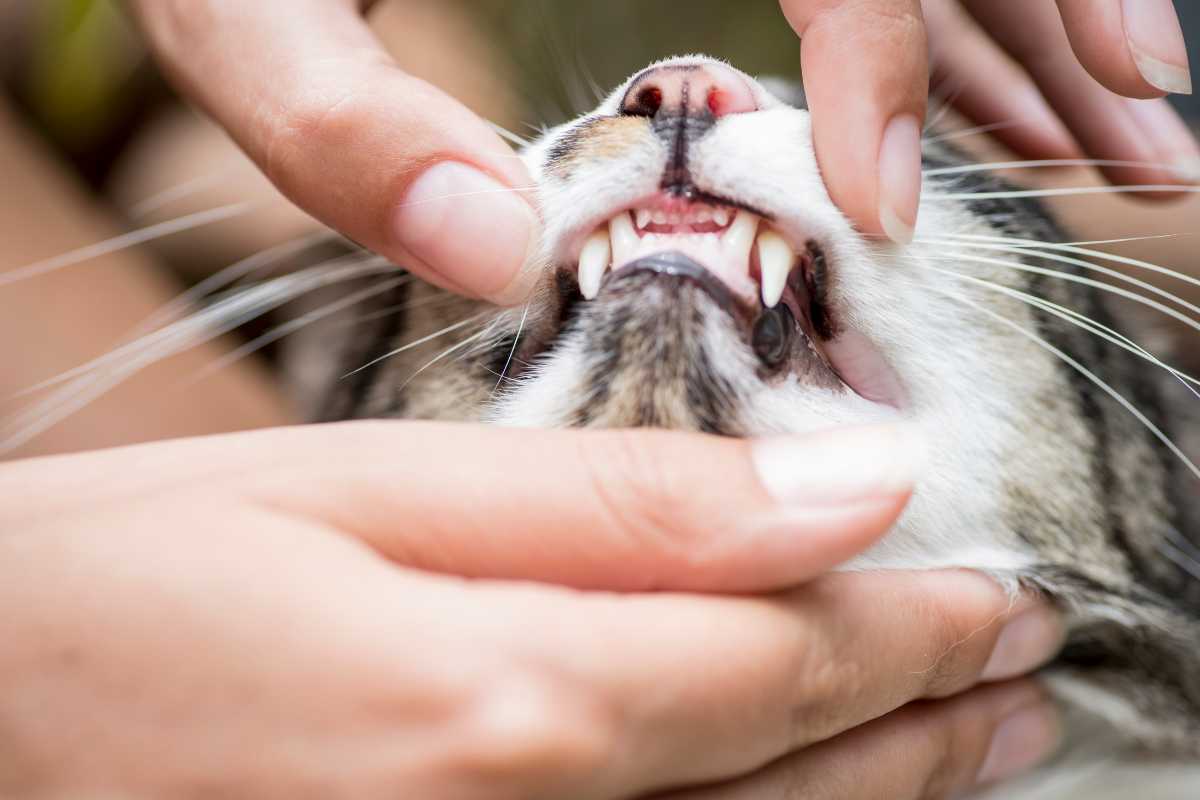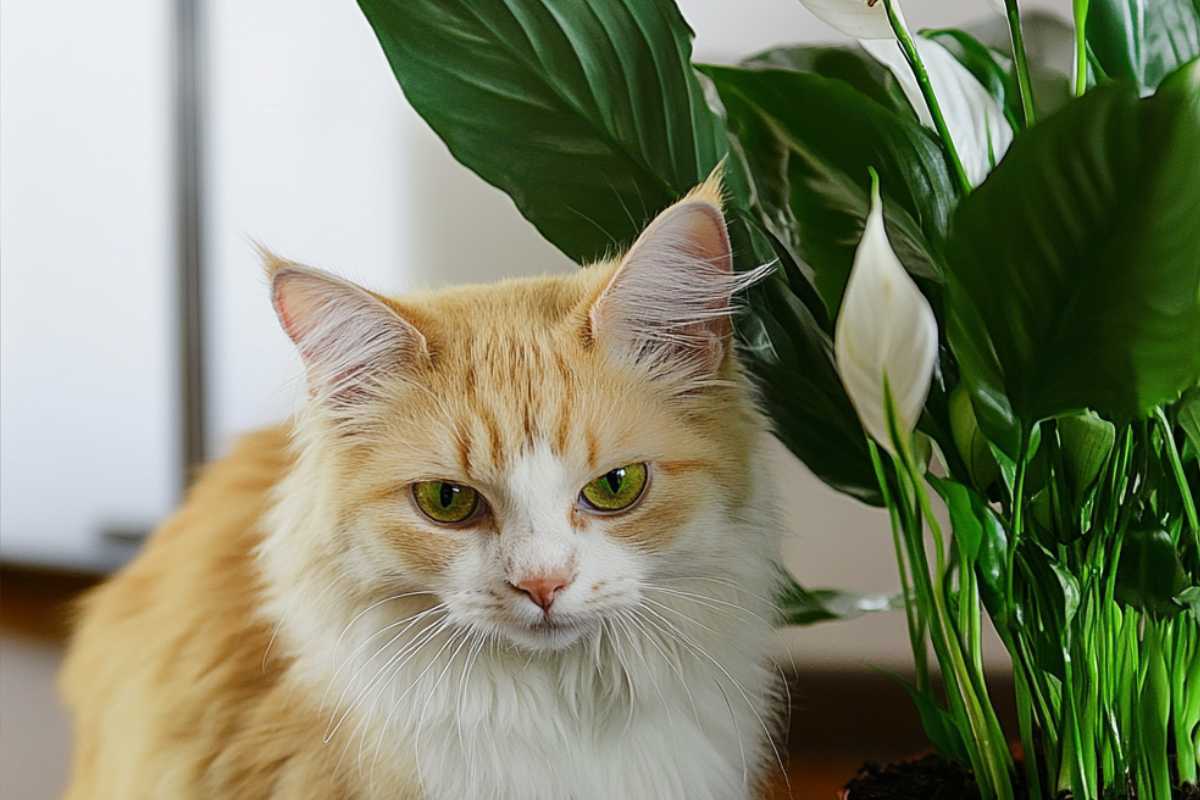Cats are adorable companions, but they may not mix well with peace lily plants. It’s essential for pet owners to know which plants can be dangerous for their furry friends.
Peace lily houseplants can be harmful to curious cats. Understanding how this beautiful plant can pose risks is important. Signs to watch for if a cat gets too close include drooling, vomiting, and difficulty swallowing.
Maintaining a home with lush greenery while ensuring a pet’s safety is possible. Here are some tips to help create a vibrant living space while keeping cats happy and healthy. It’s important to prioritize both the beauty of plants and the safety of pets.
- Related article: Tips for Growing Peace Lilies
7 Key Takeaways on Peace Lily’s Toxicity to Cats
- Peace lily plants are toxic to cats, causing symptoms like vomiting, diarrhea, and weakness if ingested.
- The toxicity comes from insoluble calcium oxalate crystals found in the leaves and stems, which can irritate a cat’s mouth and gastrointestinal tract.
- Ingesting peace lily houseplants can lead to severe oral pain, drooling, difficulty swallowing, and lethargy in affected cats.
- If the calcium oxalate crystals enter a cat’s body without sufficient urine to flush them out, they may form kidney stones, causing significant pain.
- Symptoms usually appear within 6 to 12 hours after ingestion. Contact a veterinarian immediately if you suspect your cat has eaten a peace lily.
- The bitter taste of calcium oxalate crystals may deter cats from eating large amounts, potentially reducing poisoning severity.
- Keep peace lily houseplants out of reach and consider using natural deterrents like citrus sprays or planting safe herbs nearby to protect your cat from potential harm.
Are Peace Lily Plants Toxic to Cats?

Yes, peace lily plants are toxic to cats. If ingested, they can cause distressing symptoms such as vomiting, diarrhea, weakness, seizures, and, in severe cases, coma or death. Unfortunately, there is no antidote for this toxicity.
These houseplants belong to the Araceae family and are mildly toxic due to their insoluble calcium oxalate crystals, which are found in their leaves and stems. These sharp crystals can provoke painful reactions upon contact.
When a curious cat bites any part of the plant, the crystals can pierce the soft tissues of the mouth, causing irritation and swelling. While the effects are usually not fatal, they can lead to significant suffering, so it’s essential for pet owners to keep this plant out of reach.
All parts of the peace lily contain calcium oxalate crystals. According to the American Society for the Prevention of Cruelty to animals (ASPCA), if these crystals enter the cat’s body without enough urine to flush them out, they can clump together and form kidney stones (source). This condition can be very painful and may result in gastrointestinal symptoms and oral pain when ingested by a cat.
- Read more: Peace Lily Toxicity to Dogs
Signs and Symptoms of Peace Lily Poisoning in Cats

Signs and symptoms of peace lily poisoning in cats include:
- Oral Pain and Irritation – Cats may feel severe discomfort in their mouths, leading them to paw at their face.
- Drooling – Excessive salivation often occurs due to mouth irritation.
- Vomiting – Ingesting the plant can cause vomiting, usually within hours.
- Diarrhea – Cats may experience gastrointestinal upset, leading to diarrhea.
- Difficulty Swallowing – Swelling in the mouth and throat can make swallowing painful or hard.
- Loss of Appetite – Affected cats may show less interest in food because of oral pain.
- Lethargy – Discomfort and illness can lead to reduced energy levels and overall lethargy.
- Dehydration – Persistent vomiting and diarrhea can cause dehydration, indicated by dry gums and sunken eyes.
Timeline:
Symptoms typically appear within 6 to 12 hours after ingestion, but they can take longer in some cases. If you suspect your cat has eaten a peace lily, contact a veterinarian for advice and potential treatment.
Now for some good news:
Calcium oxalate crystals in the peace lily give the plant a bitter taste, which can discourage cats from eating large amounts. This bitterness might make cats spit out the plant quickly or avoid it altogether, potentially reducing the severity of any poisoning.
However, even a small amount can cause localized irritation and discomfort, so it’s important to watch for symptoms. Some cats may still eat enough to have more serious reactions. Always consult a veterinarian if there’s any suspicion of poisoning, no matter how minor the initial response seems.
How to Treat Peace Lily Poisoning at Home

If you suspect your cat has ingested a peace lily, follow these simple steps to manage the situation at home:
- Remove Plant Material – Gently remove any remaining plant pieces from your cat’s mouth to prevent further irritation.
- Rinse the Mouth – Offer fresh water to help rinse out any leftover plant material and soothe irritation in the mouth.
- Soothe Discomfort – Give your cat a small amount of yogurt or lactose-free milk to help coat the mouth and ease discomfort caused by the plant.
- Monitor Symptoms – Watch for signs of distress like drooling, vomiting, or trouble swallowing. Most symptoms should ease quickly.
- Ensure Hydration – Keep your cat hydrated, especially if vomiting occurs. You can encourage hydration by offering wet food or adding water to their food.
- Contact a Veterinarian – If symptoms persist or worsen, such as difficulty breathing, call your vet or a pet poison hotline immediately.
Veterinary Treatment Options for Peace Lily Ingestion
If your cat ingested a peace lily within the last two hours and shows no symptoms, your veterinarian may induce vomiting to clear toxins from the stomach.
Depending on the severity of the peace lily poisoning, the vet may recommend:
- Activated Charcoal – This can help by binding to toxins, allowing them to pass safely through the digestive system.
- Lab Work – Blood tests, urinalysis, and possibly an ultrasound are important for assessing kidney function and detecting any potential damage.
- Intravenous Fluids – These help keep your cat hydrated and support kidney health, often given over 48-72 hours. Monitoring urine output ensures proper recovery.
- Medications and Treatments – Various treatments, including diuretics or supportive care, may be prescribed to protect kidney function and minimize damage.
Tips to Keep Your Cats Away From Peace Lily Plants

Prevention is the best way to avoid poisoning. Here are some effective methods to keep your curious cat away from peace lilies and other houseplants.
Try one or more of these proven ‘keep away’ tips.
1. Use Citrus Zest Spray
Cats dislike citrus scents like oranges, tangerines, and lemons, making them great for keeping your cat away from plants. The safest option is a homemade citrus zest spray.
Here’s how you can make your own homemade citrus zest to spray on your peace lily:
- Boil citrus zest in a liter of water
- Let it sit for 10 minutes
- Pour the liquid into a spray bottle to use around your plants
If you prefer a ready-made option, citrus air fresheners are also available on Amazon and other online stores.
2. Use Pepper and Mustard Spray
Dilute several teaspoons of mustard in water and then spray or sprinkle your Peace Lily and its pot with it. You can repeat this every couple of days.
Pepper can be directly sprinkled on the plant or you can dilute several teaspoons of crushed pepper in hot water and leave it to cool. Strain the mixture and then spray your plant.
3. Use Essential Citrus Oils
Using essential citrus oils can help keep cats away from your peace lilies, but it’s important to use them carefully and in small amounts. Too much can be harmful. Always dilute the oils in water. For example, mix 5 drops of orange zest oil with 500 ml of water.
Other options include eucalyptus and lavender. Never spray essential oils directly on your feline or on the plants that they chew on. You can place a cotton ball soaked in the solution in your planter and this should be adequate to keep the kitty at a distance.
4. Plant Lemon Thyme, Lavender, or Rosemary Near Your Peace Lily Plants
Plant lemon, thyme, or rosemary near your peace lily plants to keep cats at bay. Here are some reasons why:
- Strong Scents – Cats dislike strong fragrances, and these herbs have potent aromas that can deter them.
- Safe Alternatives – These herbs offer a safe option for cats to explore and nibble on, reducing their interest in the toxic houseplants.
- Companion Planting – The aromatic herbs not only beautify your garden but also create a less inviting space around the toxic plants for curious cats.
5. Spread Coffee Grounds or Garlic Cloves Around the Base of Your Peace Lily
Coffee grounds are a popular choice for repelling cats and fertilizing plants. Collect coffee grounds and place them around the base of the peace lily. Refresh the grounds regularly with fresh ones for the best results, and be sure to remove any that show signs of mold.
You can also use garlic and onion. Place halved garlic cloves around the base of the peace lily, or cut an onion in half and rub it around the edge of the plant pot to help keep cats away.
Peace Lily Toxicity to Cats Final Thoughts
The peace lily is toxic to cats due to the calcium oxalate crystals it contains. Although these houseplants aren’t as dangerous as true lilies, eating them can still cause unpleasant symptoms like vomiting and mouth pain. To keep your cat safe, it’s important to keep these plants out of reach.
Luckily, the bitter taste of peace lily plants can often stop cats from eating them. If you think your cat has ingested a peace lily, even if it seems fine at first, contact your veterinarian. By being cautious and knowing the risks, you can enjoy your houseplants while keeping your furry friend safe.
Peace Lily Toxicity to Cats FAQs
1. What Symptoms Indicate Peace Lily Poisoning in Cats?
Symptoms of Peace Lily poisoning in cats may include loss of appetite, drooling, vomiting, and oral irritation. These signs should be taken seriously.
2. Can Peace Lily Toxicity Lead to Acute Kidney Failure in Cats?
While Peace Lilies primarily cause mild gastrointestinal upset, severe reactions may lead to complications, including acute kidney failure in sensitive cats.
3. What Should I Do if My Cat Ingests a Peace Lily?
If you suspect your cat has ingested a Peace Lily, contact your emergency vet immediately. Quick action can help prevent severe health issues.
4. How Can I Prevent Peace Lily Toxicity in My Cat?
To prevent failure in cats due to Peace Lily toxicity, keep these plants out of reach or opt for non-toxic houseplants to ensure your cat’s safety.
Check out these other articles to learn more about the peace lily:
- Tips for Peace Lily Repotting
- Solutions for Drooping Leaves in Peace Lilies
- How to Revive a Dying Peace Lily?
- Brown Flowers in Peace Lilies
- https://www.aspca.org/pet-care/animal-poison-control/toxic-and-non-toxic-plants/peace-lily
- https://www.fda.gov/animal-veterinary/animal-health-literacy/lovely-lilies-and-curious-cats-dangerous-combination
- https://www.fda.gov/consumers/consumer-updates/keep-lilies-away-your-cats
- https://pubmed.ncbi.nlm.nih.gov/21147474/
- https://www.ncbi.nlm.nih.gov/pmc/articles/PMC10220692/
- https://www.poisonsinfo.health.qld.gov.au/plants-and-mushrooms/peace-lily-spathiphyllum
- https://hgic.clemson.edu/factsheet/peace-lily/
- https://plants.ces.ncsu.edu/plants/spathiphyllum/






